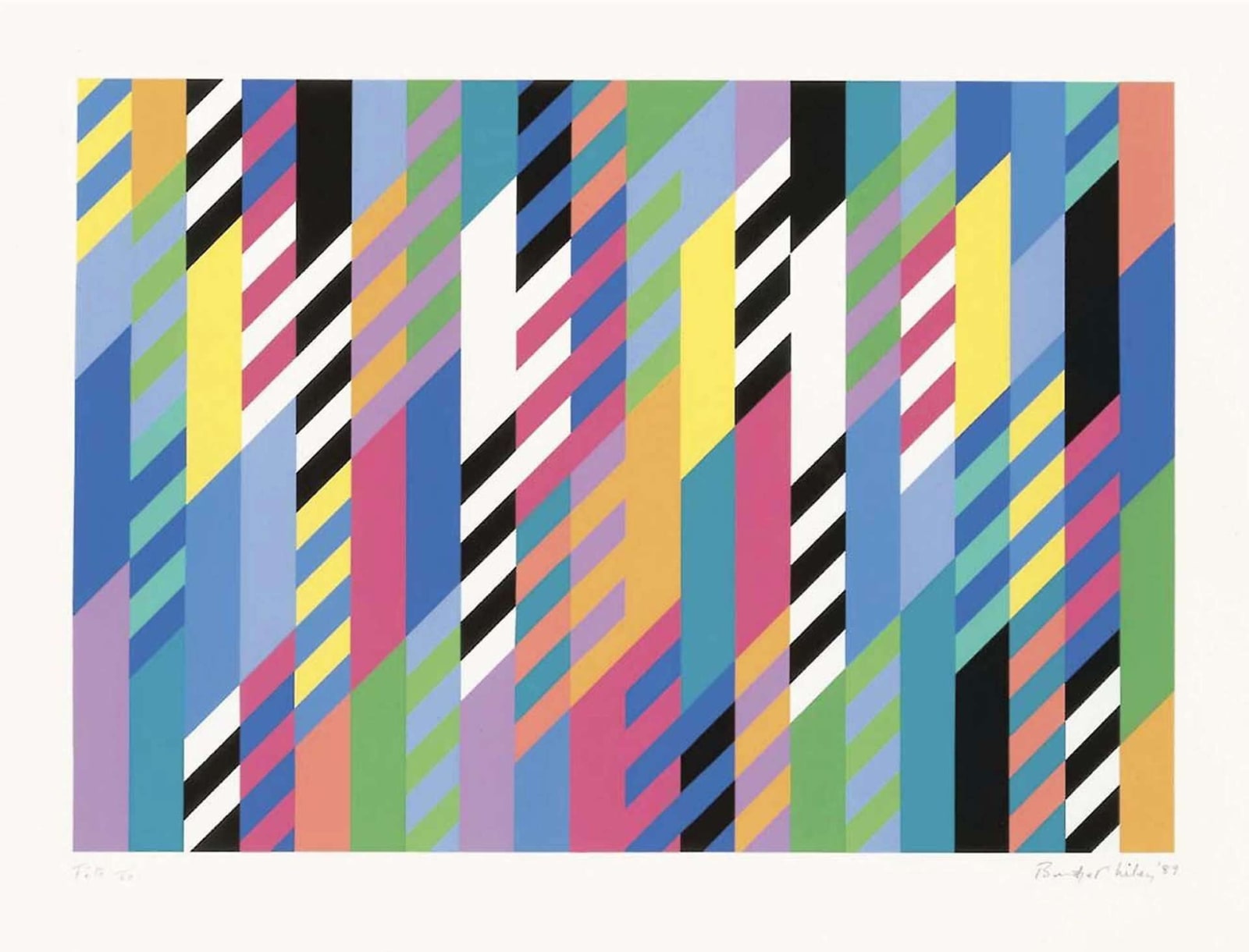Bridget Riley BRITISH, b. 1931
Fête is a screenprint featuring a highly colourful, abstract composition within a white border. The composition comprises twenty vertical bands each separated into numerous coloured sections. These sections vary in length and form parallelograms of different sizes. While the longer coloured parallelograms primarily look vertical in orientation, the smallest ones appear to cut diagonally across the upright bands. Where these latter shapes run into each other across adjacent columns and are identical in colour they also appear to form longer diagonal strips running in front of the vertical columns. The work features a wide range of even, unmodulated colours, with no discernible pattern to their organisation. The print is signed and dated in its bottom-right corner and at the bottom-left are written the title and the numbers ‘21 / 60’, which indicate that this print is number twenty-one in an edition of sixty.
This work was made by the British artist Bridget Riley in 1989, while she was living and working in London. Riley initially designed its composition in the form of a gouache painting on paper entitled February 15 ’89 1989, which is slightly larger in size than the final screenprint. At this time she commonly used gouache to plot out her compositions and it seems that the painting was a preparatory study, with the screenprint being the finished work. Fête was printed by Sally Grimson at Artizan Editions in Hove, England, both of whom she has worked with regularly since 1981. It was printed on thick, textured white paper, and as well as the edition of sixty, a set of ten artist’s proofs was produced.
The design of Fête relates to a large, untitled group of paintings on canvas, the precise number of which is not known, that Riley produced between 1986 and 1997 and which all feature vertical bands combined with diagonally oriented areas of unmodulated colour (see, for instance, High Sky 1992, Neues Museum Nürnberg, Nürnberg). She has also made two other screenprints relating to this group – Early Light 1987 and To Midsummer 1989. However, these prints are all considerably smaller than the paintings, which consistently measure over a metre in width.
The French word ‘fête’ translates into English as ‘celebration’ and could also refer to the traditional outdoor events of the same name often held in British villages. Riley may have chosen this title to emphasise the joyful quality of the work’s strong, bright colours or the energetic appearance of its dynamic composition. In 1996 she explained that she only ever selects titles after beginning to make her works and then tries to name them ‘according to their spirit’, often drawing on ‘memories of sensations in the past which have some sort of correspondence with those in the painting’. (Bridget Riley and Alex Farquharson, ‘Something To Look At: Bridget Riley in Conversation with Alex Farquharson’, in Bridget Riley: Recent Paintings and Gouaches, exhibition catalogue, Waddington Galleries, London 1996, p.11.)
Discussing the group of paintings that relate to this work in 2011, Riley stated that their compositions were intended to be ‘something like a coherent fabric of colour which advances and recedes in planes’. She claimed that this was achieved because the vertical bands are ‘broken by diagonals’ and they therefore ‘assume the potentiality of planes, being separated components which can hold different colours, which in turn can take up different positions in pictorial depth’ (Bridget Riley and Michael Harrison, ‘Bridget Riley in Conversation with Michael Harrison’, in Bridget Riley: Colour, Stripes, Planes and Curves, exhibition catalogue, Kettle’s Yard, Cambridge 2011, pp.12, 16). In other words, by cutting across the vertical bands, the diagonal sections of colour suggest layers of receding space. However, as the curator Paul Moorhouse has stated regarding the paintings relating to this work, the ‘virtual space’ they evoke is ‘unstable’ and ‘elusive’, since ‘planes of colour alternately advance and recede, suggesting positive shapes and then apertures, depending on the eye’s inclination and its response to a particular context’ (Paul Moorhouse, ‘A Dialogue with Sensation: The Art of Bridget Riley’, in Tate Britain 2003, p.24). While all of these observations apply to Fête, its smaller scale may limit the ambiguous push-and-pull described by Moorhouse.
Although she is better known as a painter, Riley has made over seventy screenprints since the early 1960s. Her printing method involves Riley composing images and having professional printmakers execute them, a process that is very close to her painting practice, since from the 1960s onwards her paintings have consistently been produced on canvas by her assistants based on her own initial designs (Craig Hartley, ‘Screenprint and the Painter’, in Schubert 2010, p.13). According to the art historian Craig Hartley, Riley prefers collaborative relationships in which printers actively suggest changes and improvements as her designs are translated into finished works. Hartley claims that this explains why Riley has so often worked with Grimson, with whom she has shared a ‘relaxed’ and ‘communicative’ relationship (Hartley 2010, p.13).
Further reading
Bridget Riley, exhibition catalogue, Sidney Janis Gallery, New York 1990.
Bridget Riley, exhibition catalogue, Tate Britain, London 2003.
Karsten Schubert, Bridget Riley: Complete Prints, 1962–2010, London 2010, p.8, reproduced no.35.
David Hodge
September 2015
